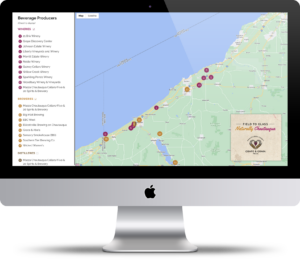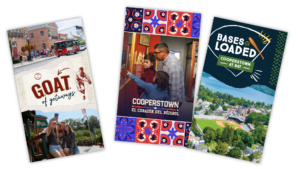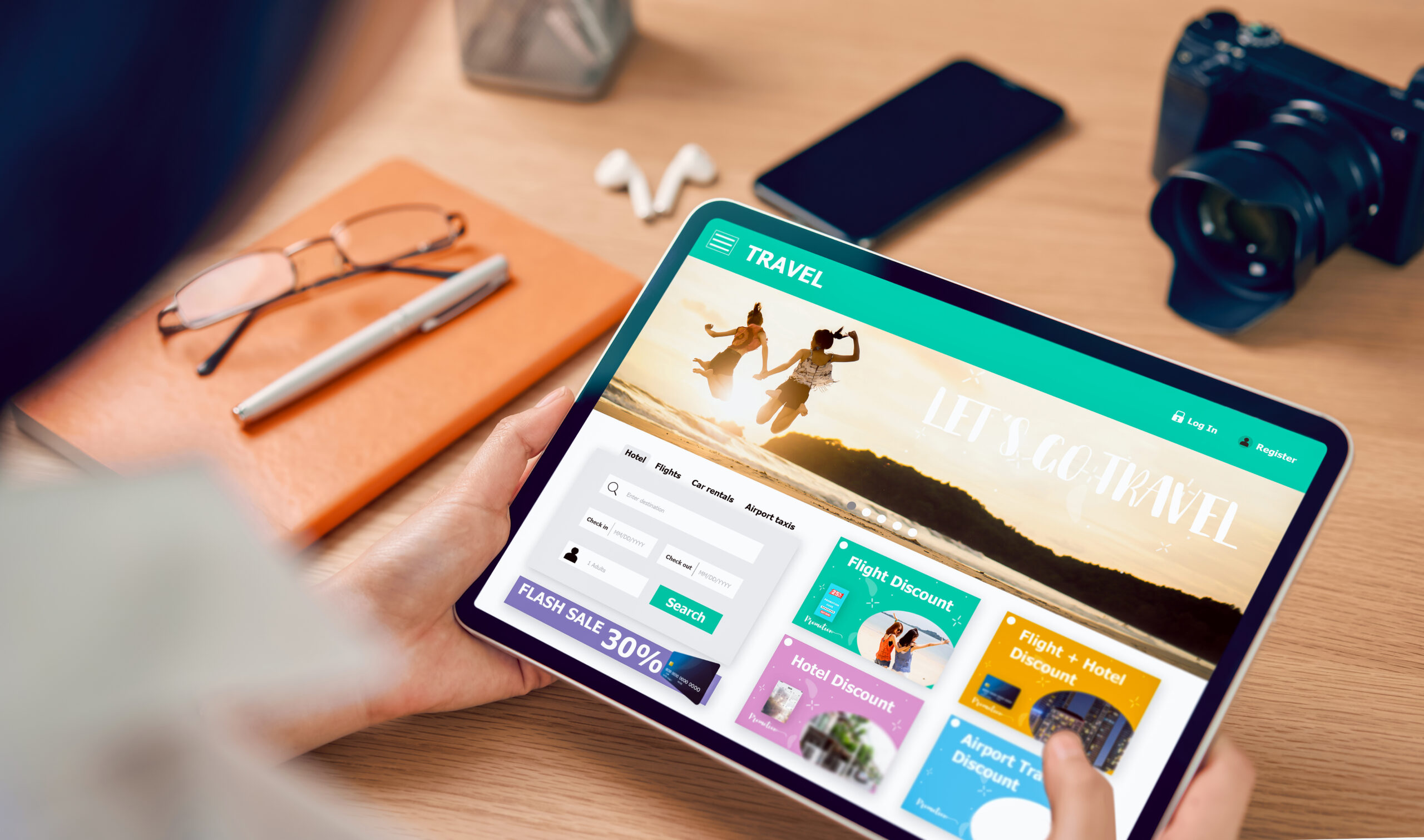What is the Digital DMO Model?
Travelers have changed how they explore the world, and destinations need a strategy that keeps up. The Digital DMO Model uses online tools, social media, and real-time engagement to connect with travelers and support local businesses. By focusing on personalized travel experiences and providing up-to-date information, you can make sure your destination stays relevant in the digital age.
The Opportunity
Digital marketing strategies provide destination marketing organizations with an opportunity to evolve and stay competitive. By adopting a digital-first approach, you can:
Speak Directly to Travelers
Building a digital experience allows DMOs to connect with travelers at all stages of their journey, from trip inspiration to in-destination decisions. This direct communication builds stronger relationships and increases engagement. For example, in our work with Destination Marketing Corporation (DMC) for Cooperstown, we run continuous marketing campaigns tailored to different audience segments, and by analyzing traveler interactions with these campaigns, we’re able to retarget key groups with lodging-specific ads, successfully driving tourism and boosting local lodging bookings.
Support Local Businesses
Digital platforms help DMOs promote local businesses more effectively through listings, targeted marketing efforts, and collaborative tourism marketing campaigns. This strengthens ties within the community while increasing economic benefits for all of your partners.
Offer Tailored Travel Experiences
Interactive features like mobile-friendly websites, custom itineraries, and maps make it easier for travelers to plan and enjoy their trips. DMOs can differentiate themselves by offering unique, curated experiences that travelers won’t find elsewhere.
Today’s travelers don’t want to hunt for information. They expect it to be right at their fingertips. Whether they’re looking for a great place to eat or a last-minute booking option, they want answers fast. By building a strong digital presence, DMOs can cut through the noise, connect with travelers where they are, and provide the kind of seamless, personalized experience that keeps them coming back.
Let’s take a look at 8 central components of the Digital DMO Model:
1. Centralized Digital Platform (Website & Apps)
A centralized digital platform, like a website or app, is your go-to hub for travelers to discover and plan their visit. It’s where they’ll find everything from destination highlights to event calendars, booking tools, and insider guides, all in one place. As you decide where to host your online presence, keep these best practices in mind:
- Prioritize Mobile-First Design: Work with a website designer to create a platform that’s optimized for mobile use, with fast loading times and an intuitive layout, since the majority of travel planning happens on smartphones.
- Simplify Trip Planning: Include interactive features like itinerary builders, real-time availability for lodging and activities, and direct booking options to make the planning process easy.
- Integrate Local Offerings: Partner with local tourism providers to showcase tours, restaurants, and experiences directly on your platform to give travelers a full view of what’s available.
- Focus on Accessibility: Incorporate accessibility features like text-to-speech, adjustable font sizes, and high-contrast options to make the experience inclusive for all users.
2. Data Analytics & Insights
Data analytics and insights give DMOs a clear understanding of what’s working and what’s not in their marketing efforts. For example, tools like Google Analytics can track how visitors are interacting with a destination’s website, identifying popular pages, where users drop off, and which social media platforms are driving traffic. This data helps DMOs adjust their strategies, like optimizing landing pages, refining digital advertising campaigns, or targeting specific demographics with tailored content.
Dashboards and reports also allow DMOs to monitor ROI on campaigns, track key metrics like booking rates and page views, and understand traveler behavior, like seasonal trends or preferred activities. By analyzing data in real-time, DMOs can make quick adjustments, like boosting an underperforming social media ad or shifting focus to a new audience segment.
Data partnerships with aggregators can also provide deeper insights into the KPIs, helping DMOs benchmark their performance against others in the tourism industry.
For example, if a DMO partners with an aggregator that tracks booking data across the region, they might learn that similar destinations are seeing an increase in last-minute bookings. This insight could prompt the DMO to shift marketing efforts toward promoting last-minute deals or weekend getaways. These partnerships also help DMOs identify gaps in their current strategies and prioritize opportunities that align with broader traveler trends
 3. Local Business Integration
3. Local Business Integration
Local business integration is a critical part of the Digital DMO Model because it directly connects your destination’s story to the people and experiences that make it unique. By building partnerships with local businesses, DMOs can amplify their reach through co-marketing efforts, like joint campaigns that promote seasonal events or highlight hidden gems. Integrating booking platforms also allows travelers a seamless way to access accommodations, tours, and attractions which can make your destination more competitive and convenient.
This integration strengthens ties within the tourism ecosystem, giving local businesses greater visibility while offering travelers a richer, more authentic experience.
Take the work we at Paperkite did with the Chautauqua Grape & Grain Trail in New York’s wine country, for example. We collaborated with the trail to create a dynamic, cohesive brand that highlighted the region’s vineyards, breweries, and craft beverage destinations. Alongside designing a new logo and launching a digital marketing campaign, we added an interactive map to their landing page. This map pinpointed local businesses and attractions which helped travelers plan their visits while driving engagement and traffic to these locations.
With tools like interactive maps, tailored itineraries, and real-time updates, DMOs can position local businesses as must-visit stops. It’s a way to create a unified digital presence that benefits everyone involved.
4. SEO and Content Strategy
SEO and content strategy play a big role in helping travelers discover your destination. Search engines are often the first place people go when planning a trip, and having a solid strategy makes it easier for your destination to show up in those searches.
To make your strategy effective:
- Create High-Value Content: Publish keyword-optimized blogs, detailed travel guides, and comprehensive event or attraction listings that answer travelers’ most common questions. For example, a blog about “Top Fall Festivals in [Destination]” can target seasonal keywords and provide direct value to your audience.
- Leverage Schema Markup: Use structured data to make your events, attractions, and reviews stand out in search results. This increases the visibility of key information like event dates or business hours, and helps travelers find exactly what they need.
- Focus on Long-Tail Keywords: Optimize content for specific, less competitive phrases like “family-friendly wineries near [Destination],” which align with travelers’ unique needs and intentions.
- Adapt for Voice and AI Search: As travelers increasingly use voice assistants or AI-powered tools for planning, make sure your content answers natural-language queries like, “What are the best weekend getaways near me?” or “Where can I find a craft brewery in [Destination]?” Creating conversational content and FAQs improves your visibility in these searches.
- Regularly Refresh Content: Update blogs, listings, and guides with new information or seasonal details to keep them relevant and rank higher on search engines.
5. Social Media Engagement
Social media is one of the best ways to connect with travelers and show off what makes your destination unique. Platforms like Instagram, TikTok, and Facebook are where people go to get inspired, plan trips, and discover new places. By posting regularly, sharing eye-catching content, and actually engaging with your followers (not just posting and forgetting), you can make sure your destination stays on their radar.
Using content from visitors—like their photos, videos, or reviews—adds a layer of authenticity that builds trust and makes your audience feel part of the story. Partnering with influencers who align with your destination’s vibe can help you reach new travelers in a way that feels approachable and fun.
Social media isn’t just about sharing beautiful pictures (though that helps). It’s about having real conversations, highlighting the unique experiences your destination offers, and getting people excited to visit. Whether it’s a quick reply to a comment, a behind-the-scenes story, or a spotlight on a local event, these interactions turn curiosity into bookings.
 6. Paid Digital Advertising
6. Paid Digital Advertising
Paid digital advertising is a smart way for DMOs to reach travelers and extend their message beyond what organic efforts can achieve. With platforms like Google Ads, you can target people who are already searching for destinations, activities, or accommodations, making it easy to show up right when they’re ready to plan. Social media ads are another effective way to raise awareness and drive traffic to your website, especially when paired with great visuals and compelling calls to action.
Retargeting campaigns are a great way to stay top of mind by showing ads to travelers who’ve already visited your website or interacted with your content in some way. Then there’s location-based campaigns, which take targeting even further by reaching people in specific areas. For instance, you can deliver ads about local events or attractions to travelers near your destination, at an airport, or even visiting a competitor’s location. Imagine someone just a few miles away seeing an ad for your upcoming festival or a limited-time promotion—they’re much more likely to act on it.
By mixing search ads, social campaigns, retargeting, and location-based strategies, you can connect with travelers at every stage of their journey—from dreaming about a trip to making last-minute plans. It’s all about showing up in the right place at the right time and making the most of your budget while keeping your destination in the spotlight.
7. Real-Time Customer Support
Real-time customer support is a must-have for today’s travelers, who expect quick answers to their questions at every stage of trip planning. Whether they’re looking for advice on the best local attractions, help booking a tour, or updates on events, being able to respond instantly builds trust and improves the user experience on your website.
Tools like live chat and AI-powered chatbots make it simple to offer 24/7 support. These solutions can handle common questions, such as operating hours or directions, and direct travelers to the right resources when needed. For a more personal touch, integrating customer service with platforms like WhatsApp or Facebook Messenger allows travelers to reach out on the apps they’re already using.
8. Personalization through CRM
CRM tools make it easier for DMOs to connect with travelers in a way that feels personal and meaningful. By segmenting your audience based on things like their interests, demographics, or past interactions, you can create email campaigns and ads that actually resonate—no more one-size-fits-all messaging.
Think about it: a foodie traveler gets an email highlighting the best local restaurants, or a family planning a trip with kids receives a suggested itinerary packed with kid-friendly activities. Those small, thoughtful touches show travelers that your destination “gets” them, making it easier for them to picture themselves there.
Looking to Take Your Destination Marketing to the Next Level?
At Paperkite, we help DMOs build digital strategies that actually work—connecting with travelers, boosting local businesses, and driving real results. Whether it’s creating a top-notch website, dialing in your social media game, or crafting data-driven campaigns, we’ll partner with you to build a Digital DMO Model that makes your destination stand out.
Let’s get started—check out our services and let’s make it happen!



